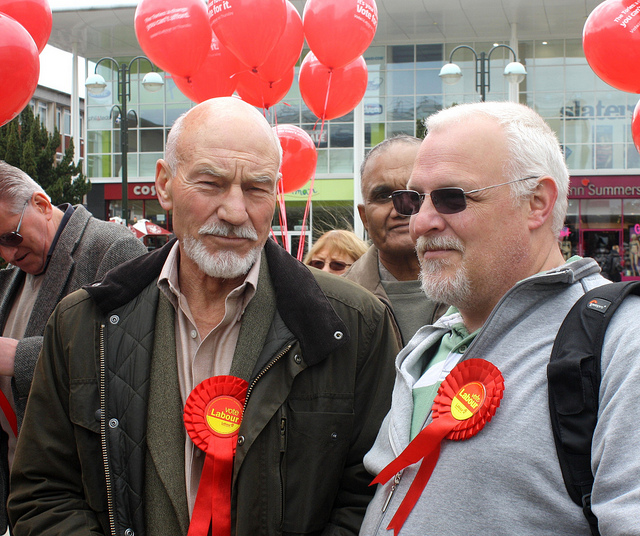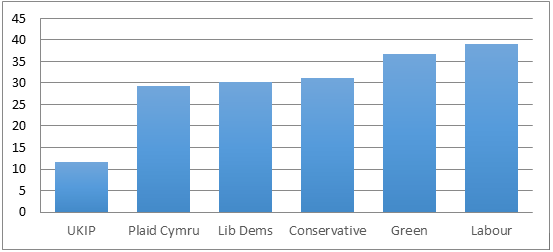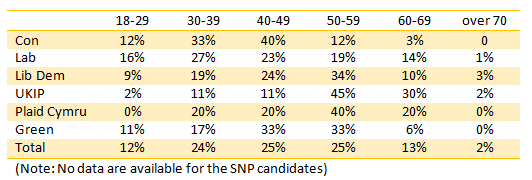Candidate selections for the General Election suggest that the political class is becoming younger and more diverse, but also more professionalised
There is a perception that Westminster politics is a self-serving career machine for the ambitions of a small cadre of self-reproducing politicians. To what extent is this view justified on the basis of the evidence? With six months until the 2015 general election Rosie Campbell, Chrysa Lamprinakou and Jennifer vanHeerde-Hudson assess the diversity of the parliamentary candidates selected so far.

Are old white men on the way out? (Credit: Andrew Skudder CC BY ND 2.0)
There can be no silencing of discussions about who governs us in the wake of the Scottish referendum. As the Westminster parties try to identify means to simultaneously fix both the Scottish and English questions, whilst maximising their electoral advantage, the electorate remains sceptical about mainstream politicians’ commitment to truly represent them. We see evidence of this scepticism in the declining turnout rates at British general elections, the rise in support for UKIP and in the 1,617,989 Scots who decided that they would prefer not to be governed from Westminster at all.
The three party leaders, who travelled up to Scotland to deliver their promise of greater devolution, may not share policy preferences, but on the surface at least they have a great deal in common. All three are white, youngish-middle-aged men with high levels of education and all are career politicians. The seeming homogeneity of the political elite feeds into a perception that Westminster politics is a self-serving career machine for the ambitions of a small cadre of self-reproducing politicians. To what extent is this view justified on the basis of the evidence? Are political parties continuing to select individuals who fit the usual mould to stand for parliament or is there evidence of increasing diversity among parliamentary candidates?
Using data from our study of parliamentary candidates (see parliamentarycandidates.org), we look at the gender, race, age and occupation of the candidates selected by party and seat winnability so far.
Sex/Gender
The Labour Party’s continued use of all women shortlists has become very topical once again. Veteran MP Austin Mitchell used the occasion of the announcement of his retirement to complain that the influx of women MPs had ‘weakened parliament’. Mitchell’s intervention was followed by a YouGov poll for The Times Redbox that showed that All Women Shortlists (AWS) remain unpopular with the electorate, although they were even more unpopular among older people and men than among women and members of younger generations. Female politicians and feminist commentators, however, have defended the use of all women shortlists to overcome bias in the parties’ selection processes.
So what is the sex balance of those seeking election to the Commons in 2015 for the seven largest parties (Conservative, Labour, Liberal Democrat, UKIP, SNP, Plaid Cymru and Green)? Of the 1440 candidates selected so far (including returning MPs) 73% are men (1045) and 27% are women (395). Excluding incumbent MPs, there are 877 candidates standing for Parliament, 70% male (613) and 30% female (264) candidates. Breaking this down by party (see Figure 1), we can see that Labour’s continued use of AWS, means a 8 percentage point advantage over the Conservatives and a 9% advantage over LibDems in terms of selecting women candidates: Conservatives 31%; Labour 39%; LibDems 30%; Green 37%; Plaid Cymru 29% and UKIP 12%.
Fig 1: Percentage of women among new candidates
Among new candidates in the 100 most marginal seats (those with 2010 margins of less than/equal to 5.37%), the Labour party has selected 30 women out of 58 candidates (52%), the Liberal Democrats have selected 11 women out of 34 (32%), the Conservatives 8 women out of 39 (21%) and UKIP trail behind with 4 women candidates out of 36 (11%). The differences are slightly starker when we consider seats where the parties came second in 2010 (i.e. marginal seats they might hope to win in the event of a positive swing). Among our top 100 most marginal seats where the parties came second in 2010, the Labour party has selected 24 women out of 42 new candidates (57%), the Liberal Democrats have selected 8 women out of 18 (44%) and the Conservatives have selected 7 women out of 31 (23%).
And finally, looking at retirement seats where the incumbent MP has stepped down and the party who won in 2010 has selected a new candidate: the Conservatives have selected 16 men (67%) and 8 women (33%); Labour have selected 6 men (25%) and 18 women (75%); the Liberal Democrats have selected 4 men (50%) and 4 women (50%) and Plaid have selected one female candidate.
Black and Minority Ethnic (BME) Candidates
Of the candidates (including returning MPs) selected thus far, we have identified 100 with a BME background. The Labour party has the highest number of BME candidates (43), followed by the Conservatives (29) Liberal Democrats (15), UKIP (8), the Greens (4) and Plaid Cymru (1).
Promisingly, 70 of the 100 BME candidates are not sitting MPs but new candidates and, and as shown in Table 1 below, seven have been selected to stand in retirement seats. Five Tory candidates, Ranil Jayawardena (Hampshire North East), Nusrat Ghani (Wealden), Seema Kennedy (South Ribble), Alan Mak (Havant) and Rishi Sunak (Richmond) have been selected in safe Conservative seats. Given the success of previous BME candidates in safe seats, it is likely that all three will represent their constituencies in Parliament in Westminster in 2015.
In addition to retirement seats, 16 BME candidates have been selected to stand in the 100 marginal constituencies, also indicating that parties are attempting to increase the number of their BME MPs. Whilst it remains to be seen whether further progress towards representation will be made in 2015, the selection of 70 new BME candidates this early on, as well as the choice of seats, suggests that the positive trend established in 2010 may continue.
Table 1: BME candidates selected in retirement seats
Age
One consequence of the professionalisation of politics has been a change in the age at which MPs begin their political and parliamentary career. Peter Riddell and Anthony King have demonstrated the shift from parliamentarians who had established careers elsewhere before entering politics, with a new generation who chose politics as a career, increasing the number of politicians first elected in their 30s and early 40s. This trend is evident in the 2015 selections.
When we compare the average age of the new candidates to the 2010 election candidates we find that the 2015 candidates are younger, with an average age of 46 years compared to 48 years of the 2010. Of the 2015 cohort selected thus far, 73% of Conservative candidates are in their 30s and 40s compared to 50% of Labour and 43% of Liberal Democrats.
The Labour party has selected a higher percentage of younger candidates (16%), compared to Conservative (12%) and Liberal Democrat (9%) candidates. Notably, however, of the three main parties, the Labour party also has a higher percentage of older candidates: 14% are in their 60s compared to 10% for the Liberal Democrats and just 3% for the Tories. Finally, our data show that the vast majority of the UKIP candidates, 75%, are in their 50s and 60s, with one-third of new candidates aged 60 or older.
Looking at retirement seats, the pattern holds for the Conservative and Labour selections. The majority, 53%, of Conservative candidates in seats in which the party’s sitting MP is standing down are in their 40s whilst most of Labour’s candidates in retirement seats, 44%, are drawn from the 30-39 age group. Overall, the data selected for the 2015 cohort thus far, confirm previous findings about the gradual rise of a younger British political class.
Occupation
Finally, we look at the previous occupation of 2015 candidates by party and specifically those candidates with ‘instrumental’ occupational backgrounds. Instrumental occupations are those that have a clear link to politics—e.g. local councillor, special advisor, party worker or union leader—and are used as ‘a means to an elected end’ (Cairney 2007).
As shown in the figure below, roughly a third of Conservative and UKIP candidates hold instrumental jobs at the time of standing for Parliament. Historically, candidates from the three main parties came to politics from established professions (e.g. solicitors/lawyers, medicine, university lecturers, etc.) or from business/industry, however, as politics has become more professionalised, the number of candidates from instrumental backgrounds has grown. This is increasingly true for Labour and the minor parties.
Figure 2: 2015 candidates: Candidates with instrumental occupational backgrounds
A new political class?
So, are the 2015 candidates really new in terms of what has come before? Is there evidence of a new political class? We draw three conclusions based on candidates selected to date. First, there is some evidence that parties are choosing a more representative set of candidates, at least in terms of sex and ethnicity. Second, candidates are slightly younger on average, but there is variation across the parties in terms of average age. And finally, there are an increasing number of candidates for whom politics is their first job, confirming evidence elsewhere showing a narrowing of the political class. One consequence of this is that it may serve to reinforce the view among many in the public that Britain’s politicians are ‘out of touch’.
There are some changes, but its early days. With six months until the 2015 general election, we’ll be keeping watch over who’s selected and elected.
—
Note: Data are correct as of 26 October 2014. The parliamentarycandidates.org project is funded by the Leverhulme Trust (RPG-2013-175). This piece represents the views of the authors and not those of Democratic Audit UK or the LSE. It originally appeared on the Constitution Unit blog and is reposted with permission. Please read our comments policy before posting.
—
 |
Rosie Campbell is Reader in Politics at Birkbeck and a Trustee of Democratic Audit UK |
 |
Chrysa Lamprinakou is a Research Associate and Teaching Fellow in British Politics at UCL |
 |
Jennifer vanHeerde-Hudson is Senior Lecturer in Political Behaviour & Departmental Graduate Tutor at UCL |









 Democratic Audit's core funding is provided by the Joseph Rowntree Charitable Trust. Additional funding is provided by the London School of Economics.
Democratic Audit's core funding is provided by the Joseph Rowntree Charitable Trust. Additional funding is provided by the London School of Economics.
MT “@democraticaudit: Is the #politicalclass is becoming younger and more diverse? https://t.co/JokEymu14G” #Democracy #representation
My spreadsheet of candidates selected so far for the 2015 general election:
https://docs.google.com/spreadsheet/ccc?key=0At91c3wX1Wu5dFkzTjFrRmJRN3F6ODBTTEs4NGFhcUE#gid=0
What do candidate selections for May 2015 so far tell us about the changing nature of the political class? https://t.co/otymCT4F3e
@GoodwayCardiff it’s part of a broader trend https://t.co/xfyRHXtiT0 there’s wider issue of the decline of parties and the selection process
@jamiepow More data from study of candidates for GE 2015! https://t.co/vN79IRT0JH
[…] Now with a full draft paper at the end. Also note some recent developments – the new 50/50 Scottish Cabinet https://www.theguardian.com/politics/2014/nov/21/nicola-sturgeon-scottish-cabinet-equal-gender-balance – and new research on Westminster candidates https://www.democraticaudit.com/?p=9386#comment-56783 […]
A comment for the trainspotters. The emphasis on ‘holding instrumental jobs at the time of standing for Parliament’ is important, to pick up on people using these occupations as stepping stones in the lead up to candidacy. Also important to examine trends in their *formative* occupations, to track how many people had an instrumental post for most of their career (which relates more to the idea that they did not have a ‘proper job’ before being elected). So, for example, there may be different trends within parties: the Conservatives take ‘proper jobs’ relataively seriously (so, more in stepping stone posts just before candidacy); Labour are more likely to have politics-facilitating posts as formative occupations.
Candidate selections suggest that the political class is becoming younger, more diverse, and professionalised https://t.co/zbSlZQGlpy
Are potential MP’s of 2015 like those elected in 2010?
https://t.co/PccWImXTCg
Candidate selection for 2015 Election suggests political class younger & more diverse, but also more professionalised https://t.co/QWo80RnNPy
What can we make of the candidates selected by the main parties? https://t.co/dfBsIEvHi3
“@democraticaudit: What can we make of the candidates selected by the main parties? https://t.co/qZ0lLtH2yo” #interesting
Is the political class is becoming younger and more diverse? https://t.co/404JMC6s0V
Candidate selections for the General Election suggest that the political class is becoming younger and more dive… https://t.co/gLTFxGVUJm
@PJDunleavy Source here is the authoritative British Candidate Survey, full details from Rosie Campbell and co on https://t.co/fMFHg7RqcL
Candidate selections for the General Election show political class getting younger, diverse, & more professionalised https://t.co/fMFHg7RqcL
Candidate selections for the General Election suggest that the political class is becoming younger and more… https://t.co/prL47EMJyk
#GE2015 candidate selections suggest the political class is getting younger and more diverse https://t.co/wZCdxm50zg via @democraticaudit